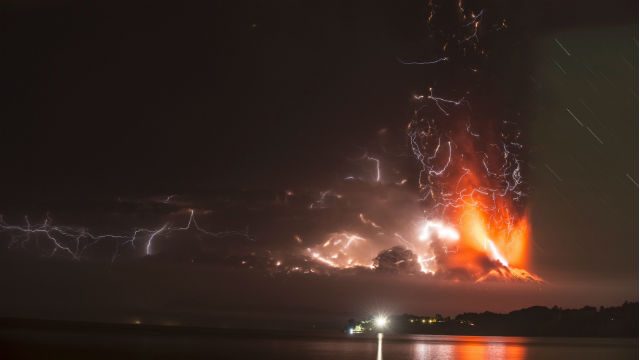SUMMARY
This is AI generated summarization, which may have errors. For context, always refer to the full article.

SANTIAGO, Chile – Spectacular bursts of volcanic lightning and lava lit up the night sky in southern Chile as the Calbuco volcano erupted twice after half a century of inactivity, forcing some 5,000 people to evacuate.
The surprise eruptions prompted officials to declare a state of emergency, send in the army and evacuate a 21-kilometer (13-mile) radius around the volcano, which last erupted in 1961 and had not shown any signs of increased activity.
There were no immediate reports of injuries, but a 21-year old mountain climber has been reported missing.
The eruptions sowed panic in the nearby port city of Puerto Montt, a tourist gateway to the popular Patagonia region whose mayor said residents were “very, very frightened,” amid warnings that melting snow and ice could flood rivers.
The massive ash clouds belched into the sky forced airlines to cancel flights and drifted as far away as southern Argentina – including the picturesque ski resort of Bariloche, which warned people to stay home to avoid inhaling dust particles.
The first eruption, which started around 6:00 pm Wednesday, April 22, and lasted about 90 minutes, spewed a giant mushroom cloud of ash 10 kilometers into the sky, which turned hues of pink and yellow as the sun set over the area.
Seven hours later, the volcano erupted again, this time shooting lava into the air and generating volcanic lightning, a phenomenon researchers believe is caused by the emission of large amounts of volcanic material charged with static electricity.
Bluish-white bolts of lightning cut through the red and orange plumes of lava in a stunning display of nature’s power that played out against the backdrop of the starry night sky.
Chile’s National Geology and Mining Service warned a third eruption was likely over the next few hours.
‘Situation unpredictable’
On a 0-8 scale measuring volcano eruption strength, the first one came in at four or five, the interior ministry said.
The second was more powerful still, said the National Geology and Mines Service.
President Michelle Bachelet said she would travel to the affected area on April 23, along with several ministers.
“The ash might damage crops, animal feed, bridges, roads, people’s work routines, tourism and especially their health,” she said.
“We don’t know how the situation is going to evolve. It’s pretty unpredictable.”
Until minutes before the blast, volcano eruption monitoring systems had picked up nothing. In fact, volcano watchers in Chile had been watching another one, Villarica, for a possible eruption.
“The explosion caused immediate hysteria among residents. We couldn’t believe what we were seeing,” said Marcia Claro, the owner of a cafeteria in Puerto Varas, a town of 38,000 people on the shores of Lake Llanquihue, at the foot of the volcano.
Television footage after the first eruption showed large traffic jams and long lines at gas stations as an ash cloud blanketed Puerto Montt, where a red alert was declared, along with nearby Puerto Varas.
Nevertheless, residents of Puerto Varas were going about their business as usual by Thursday morning – albeit with a wary eye on the volcano 40 kilometers away.
Turbulent geology
Police called on residents to keep roads as clear as possible to aid the evacuation.
“I would like to call on the population to remain calm and stay informed,” said Interior Minister Rodrigo Penailillo, who sent in the army to temporarily take control of the province of Llanquihue and the town of Puerto Octay.
School was cancelled in the region, as well as in Bariloche, in Argentina, some 100 kilometers from the volcano, where a fine layer of ash settled on roads and buildings.
At hospitals, staff shifts were rearranged to deal with the consequences of the ashfall from Chile.
The Chilean geology service said much of the ash from the volcano was headed for Argentina.
The 2,000-meter (6,500-foot) volcano is located in the Los Lagos region, some 1,400 kilometers south of the capital Santiago.
It is the second volcano in southern Chile to erupt since March 3, when Villarrica emitted a brief but fiery burst of ash and lava.
That eruption caused authorities to evacuate more than 3,500 people.
Chile has about 90 active volcanoes.
Geologist Alfredo Lahsen of the University of Chile told the long, narrow country, the world’s largest copper producer, to look on the bright side of its turbulent geology.
“If we didn’t have volcanoes, we wouldn’t have the rich gold and copper mining activity that we have in Chile. You have to see the positives, too,” he told radio station Cooperativa de Santiago. – Miguel Sanchez, AFP/Rappler.com
Add a comment
How does this make you feel?
There are no comments yet. Add your comment to start the conversation.